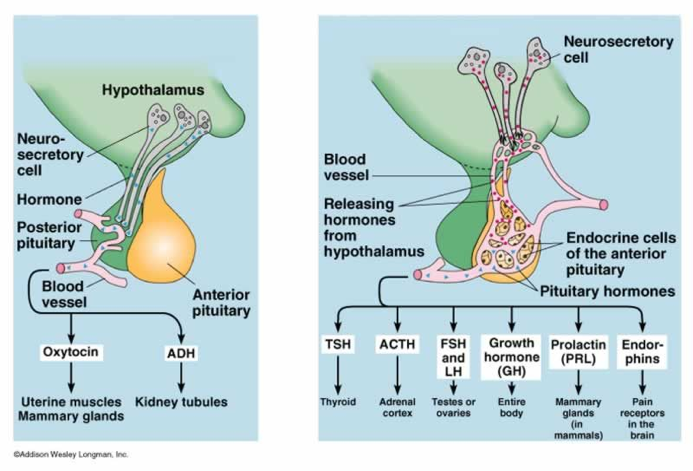What is the pituitary gland?
Even though the pituitary gland is about the size of a pea, it plays a very important role in regulating a lot of our body’s endocrine functions. Located in an area known as the sella turcica at the base of the brain and suspended from the hypothalamus by a stalk, the pituitary gland consists of two parts: the anterior/front lobe (which accounts for the majority of the pituitary gland’s weight), and the posterior/back lobe.
Development of the Pituitary Gland
Even though the anterior and posterior lobes make up the pituitary gland, their origins are different. Early on in gestation, a part of oral ectoderm invaginates and forms a protrusion called Rathke’s pouch, which eventually develops into the anterior pituitary. On the other hand, a portion of the developing hypothalamus evaginates outward to form an extension that will become the posterior pituitary. This explains why the anterior pituitary makes and secretes its own hormones under the influence of the hypothalamus’ releasing hormones, whereas the posterior pituitary hormones are actually synthesized in the cell bodies of the hypothalamus, and are eventually stored in the posterior pituitary for release.

Pituitary Gland Hormones
To understand the vital role that the pituitary gland plays in our overall well-being, we must understand the hormones that it makes and secretes, and what effects these hormones have on their respective target organs. Although there are quite a few hormones involved, there is a simple mnemonic that can help you identify the hormones secreted by each lobe of the pituitary gland on test day!
For the anterior pituitary lobe, think FLAT PEG for the following hormones:
FSH — Follicle Stimulating Hormone, which promotes ovarian follicle development, estrogen secretion in females, and spermatogenesis in the Sertoli cells of the testes
LH — Luteinizing Hormone. Which promotes ovarian follicle maturation, progesterone release, and androgen release from Leydig cells in the testes
ACTH — Adrenal Corticotropic Hormone, which stimulates the adrenal gland to secrete hormones like cortisol, aldosterone, and androgens
TSH — Thyroid Stimulating Hormone, which promotes thyroid hormone production and secretion
Prolactin — which promotes milk secretion
Endorphins — often triggered by exercise, endorphins play a major role in the body’s inhibitory response to pain and can also lead to feelings of euphoria
GH — Growth Hormone, which stimulates production of a molecule called IGF (Insulin-like Growth Factor 1) by the liver to lead to long bone growth
The posterior pituitary, on the other hand, only secretes the following two hormones:
ADH — Antidiuretic Hormone (also called Vasopressin), which helps our kidneys manage the amount of water in our body to regulate blood pressure and volume
Oxytocin — a hormone that plays a role in social bonding, sexual reproduction and childbirth
Quick Recap
In summary, understanding the origins of the two lobes of the pituitary gland can help you differentiate between the anterior lobe, which makes and secretes its own hormones (think: FLAT PEG!), and the posterior lobe, which receives hormones made by the hypothalamus and stores them until it is signaled to release them (ADH, oxytocin).
Comments